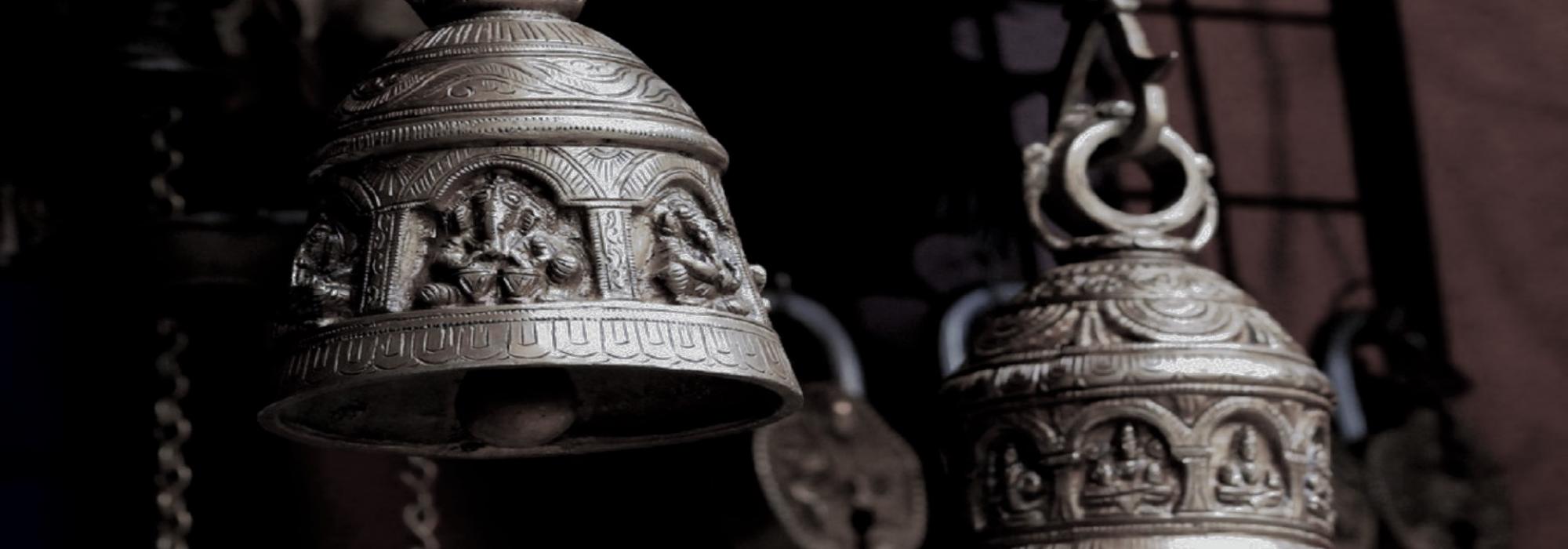ಬಾಣಭಟ್ಟ
ಮಹಾಕವಿ ಭಟ್ಟಬಾಣನ ಕೃತಿಗಳ ಪೈಕಿ “ಹರ್ಷಚರಿತ” ಒಂದರಲ್ಲಿಯೇ ಕಾವ್ಯಮೀಮಾಂಸೆಯ ಚಿಂತನಶಕಲಗಳು ಕಂಡುಬರುತ್ತವೆ. “ಕಾದಂಬರಿ”ಯ ಉಪಕ್ರಮಶ್ಲೋಕಗಳಲ್ಲಿ ಕಾವ್ಯಕಲೆಯನ್ನು ಕುರಿತ ಒಂದೆರಡು ಮಾತುಗಳಿದ್ದರೂ ಅವು ಸಾಹಿತ್ಯತತ್ತ್ವಕ್ಕೆ ನೇರವಾಗಿ ಸಂಬಂಧಿಸಿಲ್ಲ; ಮೌಲಿಕವೂ ಎನಿಸಿಲ್ಲ. ಹೀಗಾಗಿ ಹರ್ಷಚರಿತವೊಂದೇ ನಮಗಿರುವ ಆಲಂಬನ. ಇಲ್ಲಿಯ ಕೆಲವೊಂದು ಮಾತುಗಳು ನಿಜಕ್ಕೂ ಸತ್ತ್ವಪೂರ್ಣವಾಗಿವೆ. ಆರಂಭದಲ್ಲಿಯೇ ಕೃತಿಚೋರರನ್ನು ಕುರಿತು ಹೀಗೆ ಹೇಳುತ್ತಾನೆ:
ಅನ್ಯವರ್ಣಪರಾವೃತ್ತ್ಯಾ ಬಂಧಚಿಹ್ನನಿಗೂಹನೈಃ |
ಅನಾಖ್ಯಾತಃ ಸತಾಂ ಮಧ್ಯೇ ಕವಿಶ್ಚೌರೋ ವಿಭಾವ್ಯತೇ || (೧.೬)
ವರ್ಣಗಳನ್ನು ಮಾರ್ಪಡಿಸಿಕೊಂಡು, ಬಂಧಚಿಹ್ನೆಗಳನ್ನು ಮರೆಮಾಚುತ್ತ ಸಜ್ಜನರ ಸಮೂಹದಲ್ಲಿ ಗುರುತಿಗೆ ಸಿಗದಂತೆ ಬೆರೆತುಹೋಗುವ ಕವಿಯೂ ಕಳ್ಳನೂ ಒಂದೇ ವರ್ಗದವರು.
ಇದು ಶ್ಲೇಷಭೂಯಿಷ್ಠವಾದ ಪದ್ಯ. ಇಲ್ಲಿ “ವರ್ಣ”ಶಬ್ದಕ್ಕೆ ಅಕ್ಷರವೆಂದು ಕವಿಯ ಪರವಾಗಿಯೂ ಮುಖದ ಬಣ್ಣ ಬದಲಾಯಿಸುವಿಕೆಯೆಂದು ಕಳ್ಳನ ಪರವಾಗಿಯೂ ಅರ್ಥವುಂಟು. ಹೀಗೆಯೇ “ಬಂಧಚಿಹ್ನ” ಎಂಬ ಪದಪುಂಜಕ್ಕೆ ಪದ್ಯರಚನಾಕ್ರಮವೆಂದು ಕವಿಯ ಪರವಾಗಿಯೂ ಕೈಕೋಳದಂಥ ಕಟ್ಟುಗಳ ಗುರುತೆಂದು ಕಳ್ಳನ ಪರವಾಗಿಯೂ ಅರ್ಥವಿದೆ. ಇದರ ತಾತ್ಪರ್ಯವಿಷ್ಟೇ: ಕಳ್ಳನು ತನ್ನನ್ನು ಯಾರಾದರೂ ಗುರುತು ಹಿಡಿದಾರೆಂದು ಬಿಳಿಚಿಕೊಳ್ಳುತ್ತ ತನಗಾದ ಬಂಧನದ ಗುರುತುಗಳನ್ನು ಮರೆಮಾಚುತ್ತ ಸಭ್ಯಸಮಾಜದಲ್ಲಿ ಚಲಾವಣೆಗೆ ಬರುವಂತೆ ಕೃತಿಚೋರನು ತಾನು ಮೂಲಕೃತಿಯನ್ನು ಕದ್ದ ಬಳಿಕ ಅದರ ಕೆಲವೊಂದು ಅಕ್ಷರ-ಪದಗಳನ್ನೂ ಗುಣಾಲಂಕಾರಗಳನ್ನೂ ಮಾರ್ಪಡಿಸಿಕೊಂಡು ಇಡಿಯ ಕೃತಿ ತನ್ನದೆಂದು ಘೋಷಿಸುತ್ತ ಗೋಷ್ಠಿಗಳಲ್ಲಿ ಮೆರೆಯುತ್ತಾನೆ.
ಬಾಣನ ಈ ಮಾತು ಮುಂದೆ ಆನಂದವರ್ಧನ, ರಾಜಶೇಖರ, ಕ್ಷೇಮೇಂದ್ರಾದಿಗಳು ಚರ್ಚಿಸುವ ಸಾದೃಶ್ಯ, ಶಬ್ದಹರಣ, ಉಪಜೀವಿತ್ವಾದಿಗಳಿಗೆ ನೇರವಾಗಿ ಸಂಬಂಧಿಸಿದೆ.[1]
ಬಾಣನ ಕಾಲದಲ್ಲಿ ಕಾವ್ಯಶೈಲಿಗಳು ಪ್ರಾಂತೀಯವೈಶಿಷ್ಟ್ಯಗಳೆಂದೇ ಪ್ರಸಿದ್ಧವಾಗಿದ್ದವು. ಗೌಡೀ, ವೈದರ್ಭೀ, ಪಾಂಚಾಲೀ ಮತ್ತು ಲಾಟೀಯಾ ಎಂದು ಕ್ರಮೇಣ ವಿಕಸಿತವಾದ ಈ ಪದ್ಧತಿಗಳ ಬೆಳೆವಣಿಗೆಯನ್ನು ದಂಡಿ, ವಾಮನ, ರುದ್ರಟ ಮತ್ತು ರಾಜಶೇಖರರ ಕೃತಿಗಳಲ್ಲಿ ಕಾಣುತ್ತೇವೆ. ಆದರೆ ಕುಂತಕನ ಹೊತ್ತಿಗೆ ಇವುಗಳ ಪ್ರಾಂತೀಯತೆ ಗೌಣವಾಗಿ ಯಾವುದೇ ದೇಶ-ಕಾಲದ ಕವಿಯಲ್ಲಿಯೂ ಈ ಶೈಲಿಗಳನ್ನು ಗುರುತಿಸಬಹುದೆಂಬ ತಾತ್ತ್ವಿಕಪ್ರಜ್ಞೆ ಬೆಳೆದಿತ್ತು. ಇದು ಶೈಲಿಯು ಕವಿಮನೋಧರ್ಮಸಾಪೇಕ್ಷವೆಂಬ ವಿವೇಕದ ಫಲ. ಹೀಗಾಗಿಯೇ ವಿಚಿತ್ರ, ಸುಕುಮಾರ ಮತ್ತು ಮಧ್ಯಮಗಳಂಥ ಶೈಲಿಗಳು ಸ್ಥಿರವಾದವು. ಈ ಬೆಳೆವಣಿಗೆಯ ಉದ್ಗಮವನ್ನು ಬಾಣನಲ್ಲಿ ಹೀಗೆ ಗುರುತಿಸಬಹುದು:
ಶ್ಲೇಷಪ್ರಾಯಮುದೀಚ್ಯೇಷು ಪ್ರತೀಚ್ಯೇಷ್ವರ್ಥಮಾತ್ರಕಮ್ |
ಉತ್ಪ್ರೇಕ್ಷಾ ದಾಕ್ಷಿಣಾತ್ಯೇಷು ಗೌಡೇಷ್ವಕ್ಷರಡಂಬರಃ || (೧.೭)
ಉತ್ತರದವರಲ್ಲಿ ಶ್ಲೇಷಾಲಂಕಾರವೂ ದಕ್ಷಿಣದವರಲ್ಲಿ ಉತ್ಪ್ರೇಕ್ಷಾಲಂಕಾರವೂ ಎದ್ದುಕಂಡರೆ, ಪೂರ್ವದವರಲ್ಲಿ ಅಕ್ಷರವಿನ್ಯಾಸದ ಆಡಂಬರವೂ ಪಶ್ಚಿಮದವರಲ್ಲಿ ಅರ್ಥೈಕನಿಷ್ಠೆಯೂ ಕಾಣುತ್ತವೆ.
ಇದು ಪ್ರಾಂತೀಯತೆಯ ಪರಿಶೀಲನೆಯಿಂದಲೇ ಬಂದಿರುವುದು ಸ್ಪಷ್ಟ. ಸಂಪರ್ಕಸಾಧನಗಳು ಹೆಚ್ಚಿಲ್ಲದಿದ್ದಾಗ, ಕೊಡು-ಕೊಳ್ಳುವಿಕೆಗಳಿಗೆ ಅವಕಾಶವಿಲ್ಲದಿದ್ದಾಗ ಆಯಾ ಪ್ರಾಂತಗಳ ಸಹಜಪದ್ಧತಿಗಳೇ ಅಲ್ಲಿಯ ಕಲೆ-ಸಾಹಿತ್ಯಗಳ ವಿಶೇಷಗಳೂ ಆಗುತ್ತವೆ. ಇಂಥ ದೇಶೀಯವೈಲಕ್ಷಣ್ಯವನ್ನು ನಾಟ್ಯಶಾಸ್ತ್ರದ ವೃತ್ತಿ-ಪ್ರವೃತ್ತಿಗಳ ಬೆಳೆವಣಿಗೆಯಲ್ಲಿಯೇ ಗಮನಿಸಬಹುದು. ಭರತನೇನೋ ವೃತ್ತಿಗಳನ್ನು ತತ್ತ್ವನಿಷ್ಠವೆಂದು ಹೇಳಿದ್ದಾನೆ. ಆದರೆ ಅವುಗಳ ಹೆಸರುಗಳನ್ನು ಕಂಡಾಗ ಅವೂ ಮೊದಲಿಗೆ ಪ್ರಾಂತನಿಷ್ಠವಾಗಿಯೇ ಇದ್ದವೆಂದು ತಿಳಿಯುತ್ತದೆ. ಇನ್ನು ಪ್ರವೃತ್ತಿಗಳಂತೂ ಸ್ಪಷ್ಟವಾಗಿ ಪ್ರಾಂತನಿಷ್ಠಗಳೆಂಬುದಕ್ಕೆ ನಾಟ್ಯಶಾಸ್ತ್ರದ ವಿವರಗಳೇ ಸಾಕ್ಷಿ. ಆದರೆ ಯಾವುದೇ ವಿದ್ಯೆಯಲ್ಲಿ ದೇಶ-ಕಾಲಬದ್ಧವಾದ ಸೀಮಿತತೆಯಿಂದ ಮೊದಲು ಹುಟ್ಟುವ ಸಂಗತಿಗಳು ಕ್ರಮೇಣ ಪರಿಷ್ಕೃತವಾಗಿ ಸಾರ್ವತ್ರಿಕವೂ ಸಾರ್ವಕಾಲಿಕವೂ ಆದ ಮೌಲ್ಯಗಳೆಂದು ಪರಿಗಣಿಸಲ್ಪಡುವುದು ಸರ್ವವೇದ್ಯ. ಇಂಥ ಐತಿಹಾಸಿಕವಾದ ವಿಕಾಸಕ್ರಮದಲ್ಲಿ ಬಾಣನ ಪ್ರಸ್ತುತಟಿಪ್ಪಣಿಗೆ ಹೆಚ್ಚಿನ ಬೆಲೆಯಿದೆ.
ಬಾಣಭಟ್ಟನಿಗೆ ಉತ್ತಮಕಾವ್ಯದ ಬಗೆಗಿದ್ದ ಅಭಿಪ್ರಾಯ ಹೀಗೆ ಹರಳುಗಟ್ಟಿದೆ:
ನವೋऽರ್ಥೋ ಜಾತಿರಗ್ರಾಮ್ಯಾ ಶ್ಲೇಷೋऽಕ್ಲಿಷ್ಟಃ ಸ್ಫುಟೋ ರಸಃ |
ವಿಕಟಾಕ್ಷರಬಂಧಶ್ಚ ಕೃತ್ಸ್ನಮೇಕತ್ರ ದುಷ್ಕರಮ್ || (೧.೮)
ಹೊಸತಾದ ಅರ್ಥ, ಅಗ್ಗವಾಗದ ಸ್ವಭಾವೋಕ್ತಿ, ಕಷ್ಟವೆನಿಸದ ಶ್ಲೇಷ, ತಿಳಿಯಾದ ರಸ ಮತ್ತು ಆಕರ್ಷಕವಾದ ಪದಪದ್ಧತಿಗಳನ್ನು ಒಟ್ಟಿಗೆ ಹೆಣೆಯುವುದು ಕಷ್ಟ.
ಇದು ತುಂಬ ಪ್ರಾಮಾಣಿಕವೂ ಅರ್ಥಗರ್ಭಿತವೂ ಆದ ಹೇಳಿಕೆ. ಸುದೈವವೆಂದರೆ ಇಂಥ ಅರ್ಹತೆಯ ಹೆಚ್ಚಿನ ಅಂಶ ಬಾಣನಲ್ಲಿಯೇ ಇದೆ. ಇಲ್ಲಿಯ ಕೆಲವೊಂದು ಪಾರಿಭಾಷಿಕಶಬ್ದಗಳ ವ್ಯಾಪ್ತಿ ಗಮನಾರ್ಹ. ಪ್ರಕೃತದಲ್ಲಿ “ಅರ್ಥ” ಎಂದು ಬಳಕೆಯಾಗಿರುವ ಶಬ್ದದ ತಾತ್ಪರ್ಯ ರಸವಲ್ಲವೆಂಬುದು ಸ್ಪಷ್ಟ. ಏಕೆಂದರೆ ಕವಿಯು ರಸವನ್ನು ಪ್ರತ್ಯೇಕವಾಗಿಯೇ ಹೆಸರಿಸಿದ್ದಾನೆ. ಇದು ಬರಿಯ ಪದಗಳ ಅರ್ಥವೆಂಬ ಸೀಮಿತಸ್ತರದ ಅನ್ವಯವೂ ಅಲ್ಲ. ಹೀಗಾಗಿ ಬಾಣನು ಹೇಳುವ ಅರ್ಥ ಕಾವ್ಯದ ಇತಿವೃತ್ತ ಅಥವಾ ಕಥೆ ಎನ್ನಬೇಕು. ಒಟ್ಟಿನಲ್ಲಿ ಹೊಸದಾದ ಅರ್ಥವೆಂಬುದಕ್ಕೆ ನವೀನವಾದ ಕಥೆ ಅಥವಾ ಕಾವ್ಯವಸ್ತು ಎಂದು ಅಭಿಪ್ರಾಯ. ಭಾರತೀಯಸಾಹಿತ್ಯದ ಬೆಳೆವಣಿಗೆಯನ್ನು ಗಮನಿಸಿದವರಿಗೆ ಹೆಚ್ಚಿನ ರಚನೆಗಳೆಲ್ಲ ಇತಿಹಾಸ-ಪುರಾಣಗಳನ್ನೋ ಬೃಹತ್ಕಥೆಯನ್ನೋ ಆಧರಿಸಿರುವುದು ಸುವೇದ್ಯ. ಇವಕ್ಕಿಂತ ಹೊರತಾಗಿಯೂ ಅಂದವೆನಿಸಬಲ್ಲ ಇತಿವೃತ್ತಗಳತ್ತ ಕೈಚಾಚಬೇಕೆಂಬುದು ಬಾಣಭಟ್ಟನ ಇಂಗಿತವಾಗಿರಬೇಕು. ಇದನ್ನವನು ಸ್ವತಃ ಮಾಡಿಯೂ ತೋರಿಸಿದ್ದಾನೆ. ದುರ್ದೈವವೆಂದರೆ, ಇಂಥ ಹೊಸನೋಟವನ್ನು ನಮ್ಮ ಮುಂದಿನ ಕವಿಗಳಾಗಲಿ, ಆಲಂಕಾರಿಕರಾಗಲಿ ಅಷ್ಟಾಗಿ ನಚ್ಚಿಕೊಳ್ಳಲಿಲ್ಲ. ವಸ್ತುತಃ ಹೊಸತೆನಿಸುವ ಕಥೆಯನ್ನು ಹೆಣೆಯುವುದು ತುಂಬ ಕಷ್ಟ. ಹಳೆಯ ಕಥೆಯನ್ನು ಅದೆಷ್ಟು ಹೊಸತಾಗಿ ಹೇಳಿದರೂ ಆ ಕೃತಿ ಒಟ್ಟಿನಲ್ಲಿ ಉಪಜೀವಿಯೆಂದೇ ಎಣಿಕೆಗೆ ಬರುತ್ತದೆ. ಈ ಅರ್ಥದಲ್ಲಿಯೇ ಬಾಣನು ಇದೇ ಸಂದರ್ಭದಲ್ಲಿ ಉತ್ಪಾದಕಾ ನ ಬಹವಾಃ[2] ಎಂದು ಒಕ್ಕಣಿಸಿದ್ದಾನೆ.
“ಜಾತಿ”ಯೆಂದರೆ ಸ್ವಭಾವೋಕ್ತಿಯೆಂದು ಆಲಂಕಾರಿಕರು ಸ್ಪಷ್ಟಪಡಿಸಿದ್ದಾರೆ. ಇದ್ದುದನ್ನು ಇದ್ದಂತೆಯೇ ಹೇಳುವುದು ವಾರ್ತೆಯಾದರೆ ಅದನ್ನು ಅದರ ಎಲ್ಲ ಸೂಕ್ಷ್ಮತೆಗಳೊಡನೆ ಹೃದಯಂಗಮವಾಗಿ ವಿವರಿಸುವುದು ಸ್ವಭಾವೋಕ್ತಿಯ ವೈಶಿಷ್ಟ್ಯ. ಕಾವ್ಯದಲ್ಲಿ ಅತಿಶಯೋಕ್ತಿಗೆ ಯಾವ ಸ್ಥಾನವಿದೆಯೋ ಅದು ಸ್ವಭಾವೋಕ್ತಿಗೂ ಉಂಟು. ಇವೆರಡೂ ಮೂಲತಃ ವಕ್ರೋಕ್ತಿಯಲ್ಲಿ ಅಡಕವಾಗುತ್ತವೆ. ದಂಡಿಯು ವಾಙ್ಮಯವನ್ನು ವಕ್ರೋಕ್ತಿ ಮತ್ತು ಸ್ವಭಾವೋಕ್ತಿಯೆಂದು ಎರಡಾಗಿ ವಿಂಗಡಿಸಿದ್ದರೂ[3] ಅನಂತರ ಬಂದ ಭೋಜನು ಇದಕ್ಕೆ ರಸೋಕ್ತಿಯೆಂಬ ಮತ್ತೊಂದು ವಿಭಾಗವನ್ನು ಸೇರಿಸಿದ್ದರೂ ಮೂಲತಃ ಕವಿಯ ಮಾತೆಲ್ಲ ವಕ್ರೋಕ್ತಿಯೇ; ಈ ವಕ್ರತಾವ್ಯಾಪಾರವೆಲ್ಲ ರಸದಲ್ಲಿ ತಾತ್ಪರ್ಯ ಉಳ್ಳದ್ದೇ. ರಸ ಮತ್ತು ವಕ್ರತೆಗಳಿಲ್ಲದ ಉಕ್ತಿಯು ಸರ್ವಥಾ ಅಕಾವ್ಯ. ಹೀಗಾಗಿ ಬಾಣಭಟ್ಟನು ಹೇಳುವ “ಅಗ್ರಾಮ್ಯ”ತೆಯನ್ನು ಹೊಂದಿದ ಜಾತಿಯೆಂದರೆ ಅಗ್ಗವಾಗದ—ಅರ್ಥಾತ್ ವಾರ್ತೆಯೆನಿಸದ—ಸ್ವಭಾವೋಕ್ತಿಯೆಂದೇ ತಾತ್ಪರ್ಯ. ಇವನ ಸಮಕಾಲಿಕನಾದ ದಂಡಿಯು ಕಾವ್ಯಶೋಭಾಕರವಾದ ಎಲ್ಲ ಅಂಶಗಳಿಗಿಂತ ಅಗ್ರಾಮ್ಯತೆಯೇ ಹೆಚ್ಚಿನ ಸೊಗಸನ್ನು ತರುವುದೆಂದು ಹೇಳಿರುವುದು ಗಮನಾರ್ಹ.[4] ಇಷ್ಟೇ ಅಲ್ಲದೆ ಸ್ವಭಾವೋಕ್ತಿಯನ್ನು ಅಳತೆ ಮೀರಿ ಬೆಳೆಸಿದಲ್ಲಿ ಅದು ಅನಾವಶ್ಯಕವಾದ ವಿವರಗಳ ಜಾಟಿಲ್ಯದಿಂದ ಸಹೃದಯರಿಗೆ ಜುಗುಪ್ಸಾವಹವೆನಿಸುತ್ತದೆ. ಒಳ್ಳೆಯ ಸ್ವಭಾವೋಕ್ತಿಯನ್ನು ರೂಪಿಸಲು ಕವಿಗೆ ವ್ಯಾಪಕವಾದ ಲೋಕಾನುಭವ ಅವಶ್ಯ. ವಸ್ತುತಃ ಉಪಮೆ ಮತ್ತು ಸ್ವಭಾವೋಕ್ತಿಗಳನ್ನು ಸಮೃದ್ಧವಾಗಿ ನಿರ್ವಹಿಸಲು ವಿಪುಲಾನುಭವದೊಡನೆ ಸೂಕ್ಷ್ಮಪರಿಶೀಲನೆಯೂ ಬೇಕು. ಉತ್ಪ್ರೇಕ್ಷೆ-ಅತಿಶಯೋಕ್ತಿಗಳಂಥ ಕವಿಕಲ್ಪನೆಯನ್ನೇ ಪ್ರಧಾನವಾಗಿ ಉಳ್ಳ ಅಲಂಕಾರಗಳನ್ನು ಅಳತೆ ಮೀರಿ ಬೆಳೆಸಿದರೆ ಕಾವ್ಯದ ನೈಸರ್ಗಿಕಸೌಂದರ್ಯ ತಗ್ಗುವುದಲ್ಲದೆ ಕಥೆಯನ್ನು ಹೊಸ ರೀತಿಯಲ್ಲಿ ನಡಸಲು ಸಾಧ್ಯವಾಗದು. ವಿಶೇಷತಃ ಪಾತ್ರಸ್ವಭಾವಗಳನ್ನು ಗಟ್ಟಿಗೊಳಿಸಲು ಸ್ವಭಾವೋಕ್ತಿಗಿಂತ ಸೊಗಸಾದ ವಾಕ್ಯಸಾಧನ ಮತ್ತೊಂದಿಲ್ಲ. ಹೀಗೆ ಹತ್ತು ಹಲವು ನಿಟ್ಟಿನಿಂದ ಅಗ್ರಾಮ್ಯವಾದ ಜಾತಿಗಿರುವ ಸ್ಥಾನ ಮಿಗಿಲೆಂದು ತಿಳಿಯುತ್ತದೆ.
ಶ್ಲೇಷಸಾರ್ವಭೌಮನೆನಿಸಿದ ಬಾಣನು ಈ ಅಲಂಕಾರದ ಔಚಿತ್ಯ ಹೇಗಿರಬೇಕೆಂದು ಒತ್ತಿಹೇಳಿರುವುದು ಮಾರ್ಮಿಕ. ಹಲವು ಬಗೆಯ ವ್ಯುತ್ಪತ್ತಿಯನ್ನೇ ಮೂಲವಾಗಿಸಿಕೊಂಡ ಶ್ಲೇಷವನ್ನು ರಸೋಚಿತವಾಗಿ ಬಳಸಿಕೊಳ್ಳುವುದೊಂದು ಸವಾಲು. ಆದುದರಿಂದಲೇ ಅದನ್ನು ಸ್ವತಂತ್ರವಾಗಿ ತರುವುದಕ್ಕಿಂತ ಮಿಕ್ಕ ಅಲಂಕಾರಗಳಿಗೆ ಪೂರಕವಾಗಿ ತಂದರೆ ಒಳಿತು. ಶ್ಲೇಷವು ಅರ್ಥಾಲಂಕಾರಗಳಿಗೆ ಪೂರಕವಾಗಿ ಬಂದಾಗ ಶ್ಲಿಷ್ಟೋಪಮೆ, ಶ್ಲಿಷ್ಟರೂಪಕ, ಸಮಾಸೋಕ್ತಿ, ಪರಿಸಂಖ್ಯಾ ಮುಂತಾದ ಸೊಗಸಾದ ಪ್ರಭೇದಗಳು ಉನ್ಮೀಲಿತವಾಗುತ್ತವೆ. ಇವನ್ನೆಲ್ಲ ಬಾಣಭಟ್ಟನು ತನ್ನ ಕಾವ್ಯಗಳಲ್ಲಿ ಸಮೃದ್ಧವಾಗಿ ದುಡಿಸಿಕೊಂಡಿರುವುದು ದೃಷ್ಟಚರ. ಇನ್ನು ಶಬ್ದಾಲಂಕಾರಗಳಲ್ಲಿ ಶ್ಲೇಷವು ಬಂದಾಗ ಬಗೆಬಗೆಯ ಯಮಕಗಳೇ ಮೊದಲಾದ ಚಿತ್ರಕಾವ್ಯಗಳಿಗೆ ಅವಕಾಶವಾಗುತ್ತದೆ. ಈ ಆಯಾಮವು ಸಹಜವಾಗಿಯೇ ದುರ್ಬೋಧ. ಹೀಗಾಗಿ ಶ್ಲೇಷದ ಬಳಕೆ ಗುಣೀಭೂತವ್ಯಂಗ್ಯವೆನಿಸಬಲ್ಲ ಅರ್ಥಾಲಂಕಾರಗಳಿಗೆ ಮೆರುಗೀಯುವಂತೆ ಆಗಬೇಕೇ ಹೊರತು ಚಿತ್ರಕಾವ್ಯದ ಪಾರಮ್ಯಕ್ಕಾಗಿ ಅದು ಅಪವ್ಯಯವಾಗಬಾರದು. ಬಾಣನ ಇಂಗಿತ ಬಹುಶಃ ಈ ದಾರಿಯಲ್ಲಿ ಸಾಗಿರಬಹುದು. ತನ್ನ ಪೂರ್ವಸೂರಿಯಾದ ಸುಬಂಧುವಿನ ಶ್ಲೇಷಾತಿರೇಕದ ಕಾವ್ಯವನ್ನು ಕಂಡೇ ಈ ಮಾತನ್ನು ಹೇಳಿರಲೂ ಸಾಧ್ಯ!
ರಸವು ಎಲ್ಲೆಡೆ ಪರಿಸ್ಫುಟವಾಗಿರಬೇಕೆಂಬುದು ಬಾಣನ ಮತ್ತೊಂದು ಆಶಯ. ಇದನ್ನು ಭರತನಿಂದ ಮೊದಲ್ಗೊಂಡು ಎಲ್ಲ ಆಲಂಕಾರಿಕರೂ ಅಶ್ರಾಂತವಾಗಿ ಸಾರಿದ್ದಾರೆ. ಸ್ಫುಟವಾದ ರಸ ಎಂಬುದಕ್ಕೆ ಶೃಂಗಾರಾದಿರಸಗಳು ನಿಃಸಂದಿಗ್ಧರೂಪದಲ್ಲಿ ನಿರೂಪಿತವಾಗಬೇಕೆಂಬ ಅರ್ಥವಲ್ಲದೆ ಪ್ರತಿಯೊಂದು ಸಂದರ್ಭದಲ್ಲಿಯೂ ರಸಸ್ಫೂರ್ತಿಯು ಎದ್ದುಕಾಣುವಂತೆ ಇರಬೇಕೆಂಬ ಇಂಗಿತವೂ ಉಂಟು. ಇದು ಸಾಧ್ಯವಾಗುವುದು ಧ್ವನಿಸಮೃದ್ಧಿಯಿಂದಲೇ. ಅಂದರೆ, ಕಾವ್ಯವು ಶಬ್ದಚಿತ್ರವೋ ಅರ್ಥಚಿತ್ರವೋ ಆಗದೆ ವಿಭಾವ-ಅನುಭಾವಗಳ ವಿಶದಸುಂದರ ನಿರೂಪಣೆಯಾಗಬೇಕು. ಬಾಣನ ಕಾವ್ಯವನ್ನು ಕಂಡವರಿಗೆ ಅವನ ಯಾವುದೇ ವರ್ಣನೆಯಲ್ಲಿ ಈ ದೃಷ್ಟಿಯಿರುವುದು ಗೋಚರವಾಗುತ್ತದೆ.
“ವಿಕಟಾಕ್ಷರಬಂಧ” ಎಂದರೆ ಆಕರ್ಷಕವಾದ ಪದಪದ್ಧತಿಯೆಂದು ನೋಡಿದೆವಷ್ಟೆ. ಇದು ವಸ್ತುತಃ ಗುಣ-ರೀತಿ-ವೃತ್ತಿ-ಶಯ್ಯೆಗಳಿಗೆ ಸಂಬಂಧಿಸಿದೆ. ಇವನ್ನೆಲ್ಲ ಆಲಂಕಾರಿಕರು ವಿಶದವಾಗಿ ಚರ್ಚಿಸಿದ್ದಾರೆ. ಇದನ್ನು ಓದಿಸಿಕೊಳ್ಳುವ ಗುಣವೆಂದೂ ಹೇಳಬಹುದು. ಇಲ್ಲಿ ಛಂದೋಗತಿ ಮತ್ತು ಕಾವ್ಯಸಂಗೀತಗಳೂ ಅಂತರ್ಗತವಾಗುತ್ತವೆ. ಪ್ರತಿಯೊಂದು ಭಾಷೆಗೂ ತನ್ನದಾದ ವಾಗ್ಧೋರಣೆಯಿರುತ್ತದೆ. ಇದು ಶಬ್ದಗತವಾದರೆ ವಿಕಟಾಕ್ಷರಬಂಧವೆಂದೂ ಅರ್ಥಗತವಾದರೆ ವಾಚೋಯುಕ್ತಿಯೆಂದೂ ಗುರುತಿಸಬಹುದು. ವಿಕಟಾಕ್ಷರಬಂಧವು ಆಯಾ ಭಾಷೆಗಳ ಸಹಜಸುಂದರವಾದ ನಾದವನ್ನು ಅನುಸರಿಸಿ ಬಂದಾಗ ಓದುಗರಿಗೆ ಶ್ರಮವೆನಿಸದು. ಈ ಗುಣವೂ ಬಾಣಭಟ್ಟನ ಕಾವ್ಯಗಳಲ್ಲಿ ಅಪರ್ಯಾಪ್ತವಾಗಿದೆ. ಹೀಗೆ ಅವನ ಕಾವ್ಯದ ಗುಣಗಳೇ ಉತ್ತಮಕಾವ್ಯದ ಲಕ್ಷಣಗಳಾಗಿರುವುದು ಅವನ ಪ್ರತಿಭೆಗೆ ಒಳ್ಳೆಯ ನಿದರ್ಶನ. ಲಕ್ಷ್ಯಂ ದೃಷ್ಟ್ವಾ ಲಕ್ಷಣಂ ಕುರ್ಯಾತ್ ಎಂಬ ಮಾತಿನಂತೆ ಈ ಶ್ಲೋಕವು ಅಭಿಪ್ರೇತವಾಗುವ ಬಗೆಯೇ ಬೋಧಪ್ರದ.
ಬಾಣಭಟ್ಟನು ಜನವಿಮುಖವಾದ ಕಾವ್ಯದತ್ತ ಒಲವು ತೋರಿದವನಲ್ಲ. ಅವನ ಆದರ್ಶ ವ್ಯಾಸರದು. ಅದನ್ನು ಹೀಗೆ ಸಂಗ್ರಹಿಸುತ್ತಾನೆ:
ಕಿಂ ಕವೇಸ್ತಸ್ಯ ಕಾವ್ಯೇನ ಸರ್ವವೃತ್ತಾಂತಗಾಮಿನೀ |
ಕಥೇವ ಭಾರತೀ ಯಸ್ಯ ನ ವ್ಯಾಪ್ನೋತಿ ಜಗತ್ತ್ರಯೀಮ್ || (೧.೯)
ಮಹಾಭಾರತದ ಕಥೆಯಂತೆ ಎಲ್ಲ ಬಗೆಯ ವರ್ತನೆ-ವೃತ್ತಾಂತಗಳನ್ನೂ ಒಳಗೊಂಡು ಮೂರು ಲೋಕವನ್ನೂ ವ್ಯಾಪಿಸದಂಥ ಕವಿಕೃತಿಗಳಿಂದ ಏನಾಗಬೇಕಿದೆ?
ಇದೊಂದು ಅದ್ಭುತವಾದ ತಿವಿತ. ಬಾಣನು ಭುವನೋಪಜೀವ್ಯರಾದ ವೇದವ್ಯಾಸರನ್ನು ಕಾವ್ಯಾರಂಭದಲ್ಲಿಯೇ ಕವಿಬ್ರಹ್ಮರೆಂದು ಸ್ತುತಿಸಿರುವುದಕ್ಕೆ ಇಲ್ಲಿ ಒಳ್ಳೆಯ ಸಮರ್ಥನೆಯಿದೆ. ವಸ್ತುತಃ ವ್ಯಾಸರ ಸೃಷ್ಟಿಯೇ ಪ್ರತಿಯೊಬ್ಬ ಕವಿಯ ಪರಮಾದರ್ಶವಾಗಬೇಕು. ಅದು ಲೋಕಸ್ವಭಾವದ ಹೃದಯವನ್ನು ಪ್ರಕಾಶಪಡಿಸುವಂಥದ್ದು. ಜೊತೆಗೆ ರೂಪ-ಸ್ವರೂಪಗಳಲ್ಲಿ ಅಷ್ಟು ಸಂಕೀರ್ಣವಾಗಿದ್ದರೂ ಅದು ಸಕಲರಸಿಕರಿಗೆ ಆಸ್ವಾದ್ಯವೆನಿಸಿರುವುದು ಮತ್ತೂ ಹೆಚ್ಚಿನ ಗುಣ. ಬಹುಶಃ ಬಾಣಭಟ್ಟನ ಈ ಮಾತನ್ನೇ ರಾಜಶೇಖರನು ಹೀಗೆ ಮರುದನಿಸಿದ್ದಾನೆ:
ಏಕಸ್ಯ ತಿಷ್ಠತಿ ಕವೇರ್ಗೃಹ ಏವ ಕಾವ್ಯ-
ಮನ್ಯಸ್ಯ ಗಚ್ಛತಿ ಸುಹೃದ್ಭವನಾನಿ ಯಾವತ್ |
ನ್ಯಸ್ಯಾವಿದಗ್ಧವದನೇಷು ಪದಾನಿ ಶಶ್ವತ್
ಕಸ್ಯಾಪಿ ಸಂಚರತಿ ವಿಶ್ವಕುತೂಹಲೀವ ||
(ಕಾವ್ಯಮೀಮಾಂಸಾ, ನಾಲ್ಕನೆಯ ಅಧ್ಯಾಯ, ಪು. ೧೩)
ಒಬ್ಬ ಕವಿಯ ಕಾವ್ಯ ಅವನ ಮನೆಯಲ್ಲಿಯೇ ಉಳಿಯುತ್ತದೆ. ಮತ್ತೊಬ್ಬನ ಕೃತಿ ಗೆಳೆಯರ ಮನೆಗಳನ್ನು ಮುಟ್ಟುತ್ತದೆ. ಯಾರೋ ಒಬ್ಬನ ಕವಿತೆ ಮಾತ್ರ ಸಾಮಾನ್ಯರ ಬಾಯಿಗಳಲ್ಲಿಯೂ ಪದವಿಟ್ಟು ವಿಶ್ವಕುತೂಹಲಿಯಂತೆ ಜಗವನ್ನೆಲ್ಲ ಸುತ್ತುತ್ತದೆ.
ಒಟ್ಟಿನಲ್ಲಿ ಬಾಣಭಟ್ಟನ ಪ್ರಾಮಾಣಿಕತೆ ಮತ್ತು ಆತ್ಮವಿಶ್ವಾಸಗಳು ಆತನ ಕಾವ್ಯಮೀಮಾಂಸೆಯ ಒಳನೋಟಗಳ ಮೆರುಗನ್ನು ಹೆಚ್ಚಿಸಿವೆ, ಜಿಜ್ಞಾಸುಗಳಿಗೆ ಉಪಾದೇಯವೂ ಆಗಿವೆ.
[1] ಧ್ವನ್ಯಾಲೋಕ, ೪.೧೧-೧೩; ಕಾವ್ಯಮೀಮಾಂಸಾ, ೧೧-೧೩ ಅಧ್ಯಾಯಗಳು; ಕವಿಕಂಠಾಭರಣ, ೨.೧
[2] ಹರ್ಷಚರಿತ, ೧.೫
[3] ಕಾವ್ಯಾದರ್ಶ, ೨.೩೬೩
[4] ಕಾವ್ಯಾದರ್ಶ, ೧.೬೨















































